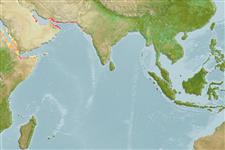>
Gobiiformes (Gobies) >
Gobiidae (Gobies) > Gobiinae
Etymology: Bathygobius: Greek, bathys = deep + Latin, gobius = gudgeon (Ref. 45335); karachiensis: Named after the city Karachi.
Environment: milieu / climate zone / depth range / distribution range
Ecología
marino demersal; rango de profundidad 1 - 2 m (Ref. 35815). Tropical
Distribución
Países | Áreas FAO | Ecosistemas | Ocurrencias, apariciones | Point map | Introducciones | Faunafri
Western Indian Ocean: Pakistan.
Tamaño / Peso / Age
Maturity: Lm ? range ? - ? cm
Max length : 5.9 cm SL macho / no sexado; (Ref. 47438)
Short description
Claves de identificación | Morfología | Morfometría
Espinas dorsales (total) : 7; Radios blandos dorsales (total) : 9; Espinas anales: 1; Radios blandos anales: 8; Vértebra: 27. Brown Bathygobius with anterior and posterior oculoscapular canals connected to each other (4 supra opercular pores). Scales along the body 35-36; transverse series of scales, 14-15; cheek and opercle without scales; preventral with cycloid scales, pectoral base 3-4 rows of cycloid scales; predorsal scales 13-21 reaching slightly anterior to hind preopercular margin; a skinny flap on anterior nostril; mental flap short lateral lobes deep, 2 upper pectoral rays free each with 4-5 branches. 5 saddle-like blotches from dorsal side not exceeding mid trunk. Mid-lateral line with 7 small elongate spots, one dark spot behind eye, another at base of free pectoral rays.
Life cycle and mating behavior
Madurez | Reproducción | Puesta | Huevos | Fecundidad | Larva
Hoda, S.M.S. and M. Goren, 1990. Bathygobius karachiensis (Gobiidae), a new species from Pakistan. Cybium 14(2):143-150. (Ref. 35815)
IUCN Red List Status (Ref. 130435: Version 2024-2)
Threat to humans
Harmless
Human uses
Herramientas
Special reports
Download XML
Fuentes de Internet
Estimates based on models
Preferred temperature (Ref.
123201): 26.2 - 28.5, mean 27.4 °C (based on 147 cells).
Phylogenetic diversity index (Ref.
82804): PD
50 = 0.5000 [Uniqueness, from 0.5 = low to 2.0 = high].
Bayesian length-weight: a=0.00724 (0.00339 - 0.01546), b=3.10 (2.92 - 3.28), in cm total length, based on LWR estimates for this (Sub)family-body shape (Ref.
93245).
Nivel trófico (Ref.
69278): 3.4 ±0.5 se; based on size and trophs of closest relatives
Resiliencia (Ref.
120179): Alto, población duplicada en un tiempo mínimo inferior a 15 meses (Preliminary K or Fecundity.).
Fishing Vulnerability (Ref.
59153): Low vulnerability (10 of 100).
